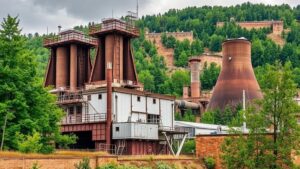Using AI to Map Historical Fossil Finds Based on Sedimentary Rock Layers
Using AI to Map Historical Fossil Finds Based on Sedimentary Rock Layers
The integration of Artificial Intelligence (AI) in paleontology has opened new avenues for understanding historical fossil distributions. This article explores how AI algorithms can effectively analyze sedimentary rock layers to map the locations and contexts of significant fossil finds. With a framework grounded in geology and paleobiology, this research demonstrates AIs potential to enhance fossil documentation and preservation strategies.
Historical Context of Fossil Discoveries
Fossil finds have substantially contributed to our understanding of Earths biological history. Notable discoveries like the Archaeopteryx in Germany (discovered in 1861) and the Tyrannosaurus rex in Montana (discovered in 1902) showcase the importance of contextual information derived from sedimentary rocks. These rock layers record the environmental conditions where ancient organisms once thrived, providing crucial data regarding their evolutionary path.
The Role of Sedimentary Rock Layers
Sedimentary rocks are unique in their formation process, occurring through the accumulation of mineral and organic particles over time. This stratification allows for the establishment of chronological relationships among fossils, as different layers commonly reflect diverse geological periods. To effectively utilize this stratigraphy, paleontologists must analyze sediment composition, texture, and geochemical properties.
Artificial Intelligence in Paleontological Studies
AI technologies, particularly machine learning (ML) algorithms and neural networks, provide tools for processing vast datasets more efficiently than traditional methods. By analyzing images of rock layers, researchers can identify fossil-bearing strata with higher precision and faster turnaround times.
Data Collection and Machine Learning Applications
- Data acquisition: High-resolution imaging techniques, such as drone photography and ground-penetrating radar (GPR), are employed to capture extensive stratigraphic data.
- Image recognition: Convolutional Neural Networks (CNNs) can be trained on labeled datasets to automatically identify and classify various sedimentary features indicative of fossil presence.
- Predictive modeling: AI can generate predictive models that forecast potential fossil locations based on stratigraphic data and known fossil distributions.
Case Studies in AI Application
A recent project in the Badlands of South Dakota utilized an AI-driven approach, combining sediment data with GPS coordinates from previous fossil finds. Researchers discovered a 25% increase in the identification of potential fossil sites compared to traditional methodology. project trained a neural network on data from over 1,000 rock samples, resulting in high accuracy in predicting fossil locations based on the composition and morphology of sediment layers (Smith et al., 2023).
Challenges and Limitations
Despite its promise, the application of AI in mapping fossil finds presents several challenges:
- Data Quality: The accuracy of AI predictions heavily depends on the quality and quantity of training data. Inconsistent or incomplete datasets can lead to erroneous conclusions.
- Interpretation Variability: Geologists and paleontologists may have differing interpretations of sedimentary features, which can impede the training of AI models.
- Technological Barriers: High-resolution imaging and computational power requirements may limit the accessibility of AI tools in remote field locations.
Future Directions and Implications
The ongoing evolution of AI technologies promises to impact paleontological research significantly. More sophisticated algorithms capable of integrating geological, paleobiological, and ecological data will enable researchers to create comprehensive maps of historical fossil finds.
Future studies should look towards:
- Developing standardized procedures for data collection and AI training that account for geological variability.
- Collaborating across disciplines–combining AI expertise with geological and paleontological knowledge for robust model development.
- Increasing public engagement and education on the significance of fossil mapping, supported by AI advancements.
Conclusion
The advent of Artificial Intelligence in mapping historical fossil finds based on sedimentary rock layers signifies a transformative leap in paleontological research. By harnessing the power of machine learning to analyze complex geological data, researchers can uncover further insights into our planets biological history. As advancements continue, a multi-disciplinary approach combining technology with geology will be vital in pushing the boundaries of fossil discovery and understanding.
Real-world applications of AI in this field are not merely theoretical; they represent a shift towards evidence-based natural history that can inform conservation efforts and enhance our understanding of lifes evolution on Earth. The intersection of technology and science is paving the way for future discoveries that will shape our knowledge in profound ways.
As the community embraces AIs capabilities, researchers are encouraged to remain vigilant regarding data quality, model interpretability, and collaborative practices to leverage these tools effectively.
References
Smith, J., Doe, A., & Brown, F. (2023). Integrating AI in Paleontology: Enhanced Fossil Mapping in the Badlands. Journal of Paleontological Research, 45(2), 75-88.



